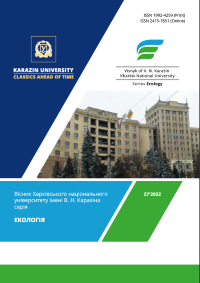Математичні моделі для оцінки екологічних наслідків впливу пірогенного фактору на лісові екосистеми
Анотація
Надано результати аналізу основних параметрів горіння лісових масивів: площа, пройдена вогнем, тривалість пожежі, час вигорання, питома маса горючих матеріалів, енергія та потужність горіння, питома теплотворна здатність, інтенсивність горіння, швидкість переміщення фронту горіння, приплив горючих матеріалів тощо. Створено прості аналітичні математичні моделі протікання процесу горіння великих лісових масивів, а саме: модель з постійною швидкістю зростання площі пожежі, двовимірна модель, модель з секторним рухом фронту горіння, модель з лінійним зростанням у часі довжини фронту горіння, модель з квадратичним зростанням у часі швидкості зміни площі пожежі та узагальнена модель. Запропонована нова класифікація інтенсивності пожеж, що містить 1–7 балів від наднизької до екстремальної інтенсивності. Оцінено максимальну площу, охоплену пожежею, (10–100 тис. км2), енергію горіння (1–10 ЕДж) та потужність горіння (0.1–1 ПВт).
Висновки. Розроблено прості аналітичні математичні моделі протікання процесу горіння великих лісових масивів, необхідні для кількісної оцінки екологічних наслідків пожеж.
##submission.downloads##
Опубліковано
Номер
Розділ
Ліцензія
Авторське право (c) 2022 Чорногор Л. Ф., Некос А. Н., Тітенко Г. В., Чорногор Л. Л

Ця робота ліцензується відповідно до Creative Commons Attribution 4.0 International License.
Автори, які публікуються у цьому журналі, погоджуються з наступними умовами:
- Автори залишають за собою право на авторство своєї роботи та передають журналу право першої публікації цієї роботи на умовах ліцензії Creative Commons Attribution License 4.0 International (CC BY 4.0), котра дозволяє іншим особам вільно розповсюджувати опубліковану роботу з обов'язковим посиланням на авторів оригінальної роботи та першу публікацію роботи у цьому журналі.
- Автори мають право укладати самостійні додаткові угоди щодо неексклюзивного розповсюдження роботи у тому вигляді, в якому вона була опублікована цим журналом (наприклад, розміщувати роботу в електронному сховищі установи або публікувати у складі монографії), за умови збереження посилання на першу публікацію роботи у цьому журналі.
- Політика журналу дозволяє і заохочує розміщення авторами в мережі Інтернет (наприклад, у сховищах установ або на особистих веб-сайтах) рукопису роботи, як до подання цього рукопису до редакції, так і під час його редакційного опрацювання, оскільки це сприяє виникненню продуктивної наукової дискусії та позитивно позначається на оперативності та динаміці цитування опублікованої роботи (див. The Effect of Open Access).

